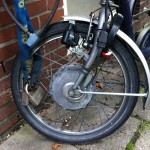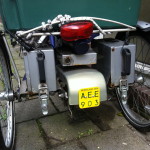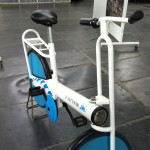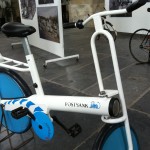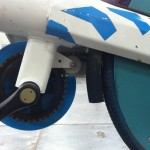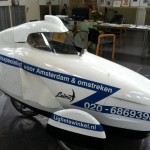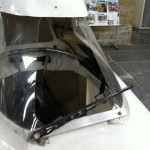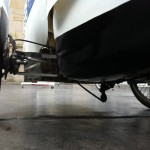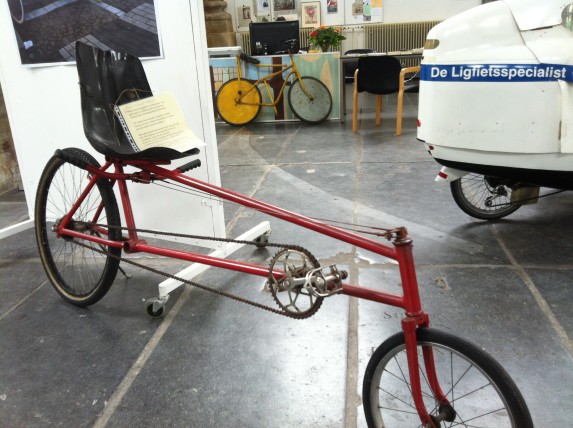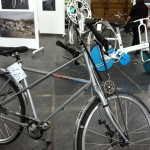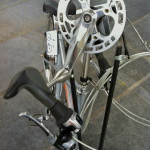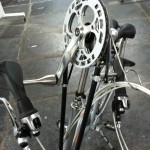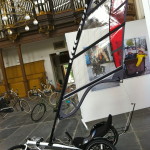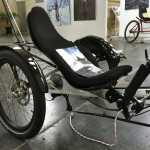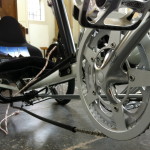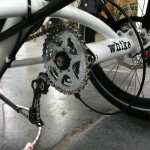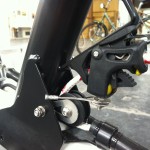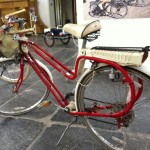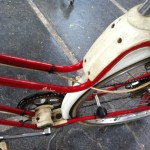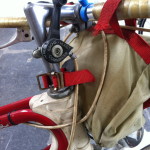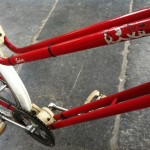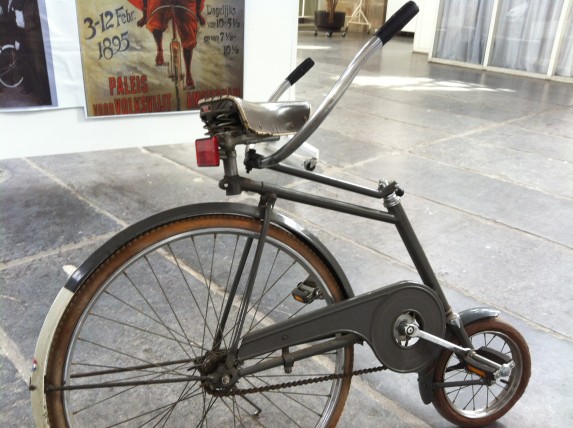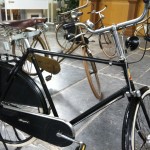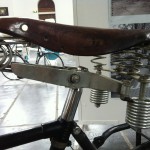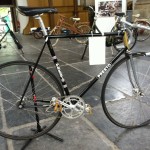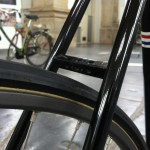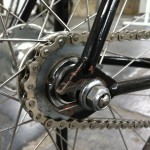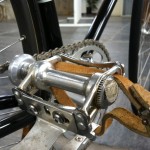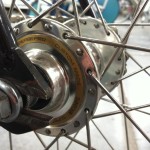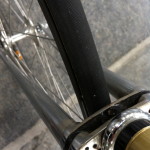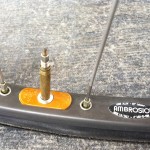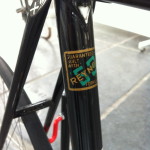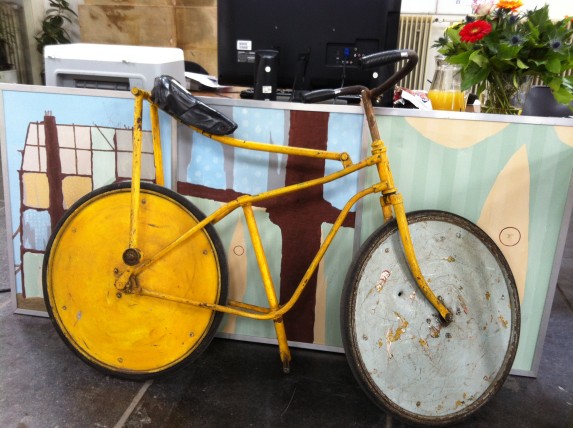“Fiets” is one of the first Dutch words that I learned after I got here. It means “bicycle”. I sought out the Amsterdam fietsmuseum for obvious reasons, and Em went along with it graciously.
I saw an interesting vehicle on the walk to the place – a beefy-looking electric assist tricycle.
- There’s a lot going on around this front wheel. Following the rim from left to right: chain lock, dynamo (generator) that rubs against the tire to power the lights, V-brake, fork, integrated lock. Also, this is the LARGEST FRONT HUB I’VE EVER SEEN. Turns out it’s a hub motor as evidenced by the electrical cable running to it and the torque arm attached to the fork.
- Some serious battery power.
We got to the address listed, but there was nothing that looked like a bike museum around – just a church at the end of the street, a grocery store, and a bunch of apartments. I asked a clerk at the grocery store if she knew about the fietsmuseum which was supposed to be nearby. She didn’t speak much English, but I think she was saying no – she didn’t know about it. We walked around a little bit and realized that the address for the museum was the same as the address for the church. There was no fietsmuseum signage on the outside. I was pretty sure we were in the wrong place. I made sure it was open at the time, but maybe it had moved; maybe Google Maps took me to the wrong place; maybe there was some important message on the Dutch-only website that I couldn’t understand. We walked into the church. The fietsmuseum was inside the church. Turns out it is run by one person – the woman behind the desk. Aside from a couple of people who walked out as we walked in, we were the only other people in there for the entire hour and a half or so of our visit.
Said director of the fietsmuseum was excited to have some visitors, I think. It was a bit like this scene from Sweeny Todd.
So she was excited to give us a brief history of cycling in the Netherlands, aided by the posters around the perimeter. To set the stage, she said that while in many countries, cycling is seen the poor person’s alternative to cars, in the Netherlands, they were first seen as a form of luxury. When bicycles were fairly new, a king a while back popularized cycling by riding his bicycle around for leisure, and much of the royalty thereafter have been cyclists. There was a photo from bicycle protests in the 70s about casualties from car versus bicycle accidents and another photo from what is commonly known as the first bike sharing program (which came out of the Provo movement in the 1960s).
That bicycle sharing program didn’t last long, she said, because people naturally wanted their own bicycles. It’s consistent with the history I had seen about it. Most of the bikes disappeared quickly. Originally, they were all white, but people kept them and painted them a different color to make them look as though they were not the “white bikes”.
The museum had a bike from another bike sharing program. This time around, the bikes were designed to look weird so that even with a paint job, they would be immediately recognizable as the shared bikes. However, she told us that this one also failed quickly for the same reason – people just wanted their own bicycles.
- Note that the rear rack is welded to the frame. Also, the seatpost seems to be deliberately oddly shaped – maybe as a theft deterrent mechanism.
- The idler pulley makes the chain disappear alongside the narrow chain guard. Also, check out those snazzy blue tires!
The director told us that most of the bikes in the fietsmuseum collection are Dutch-made, with some from France. I spotted at least one from the UK though (a Brompton folding bike). She seemed to have quite a bit of Dutch pride. She also had a wall showing a Dutch track racing champ who set some world record a while back, and she grumbled that the reason the Dutch have not had more Tour de France champions (than their two at the time) is that they don’t use enough drugs.
There was a fast-looking clamshell tricycle with a hand-operated windshield wiper. The director said that if one uses that windshield wiper while riding, one will end up in the trees on the side of the road.
A cleverly hacked-together prototype of an early recumbent bicycle stretched out nearby. It was made by one of the pioneers of recumbent bicycles. This one is relatively high off the ground compared to most of them around these days. It has no brakes.
I noticed this crazy contraption on the website – a two-wheel drive bicycle. The rear wheel is driven by the pedals, and the front wheel is driven by hand cranks. I really wanted to ride this one in order to fully experience how bananas this design is. It’s an interesting experiment. The director said it was too complicated to be practical. I imagine that riding it is like flying a helicopter while eating a sandwich and holding a drink between one’s legs.
This sailbike is probably the most Dutch thing I have seen so far. This version starts at €3,745 at the moment, which is actually cheaper than I expected, not that I’m thinking of buying one. However, I found a place where I can rent one! They even make an electric assist version, which seems absolutely excessive.
- Each brake lever pulls two cables.
- A standard Shimano drivetrain
- The front brake lever operates both the front disc brake and this sail release
This contraption was made at a time when plastic was a new idea, so naturally, it features an abundance of plastic. I wonder if all the carbon fiber frames made today will look like this in 50 years. Maybe they will show up in museums like this if any of them are unbroken after that long (zing!). The director has ridden this one around and says it’s surprisingly strong and comfortable.
I’ve seen this wood bike around town a few times. It looks kind of fun. I imagine it’s quite flexible, but maybe a viable idea as a commuter bike. Those wood fenders blend right in. Changing the handlebars doesn’t seem like an option, but that’s the same situation with Jan, the old-fashioned commuter I bought here.
This one was an attempt to have a more compact frame. The director offered to let me ride it, which was quite nice! It’s as awkward to ride as it looks, but it’s fun as a novelty. Steering feels like the action of swinging a hula hoop around one’s waist to get it started. Also, she mentioned that Mussolini appeared in a video riding this bike, which quite unfortunately killed the PR for it.
Check out the springs (and rod brakes) on this old-fashioned number!
After I saw how many photos I got of this classic track bike, I realized it was probably my favorite. The simplicity is quite astounding. Nothing unnecessary – just a frame, a drivetrain, and steering.
- It looks fast, even for today’s standards, but it seems to be from the 80s
- With this diamond-shaped bridge, you can’t mount a rear brake due to the angle – and why would you want to? It’s a track bike!
- The only place this bike shows wear is where it should
- I suppose it was made before clipless pedals were a thing.
- Nice circular pattern in the crown. Also, perhaps this wheel was built before radial spoke patterns were popular – I imagine it would have a radially-spoked front wheel today.
- Even the valve hole in the rim has a classy detail.
This stationary bike reminded me of my Grandma Teresa. She has one in her living room, and she rides it when no one is looking.
Our host concluded the tour with a couple of joke bikes. First, this bike towing a car.
And then this circus bike, which is powered by sitting at the appropriate point in the cycle.
